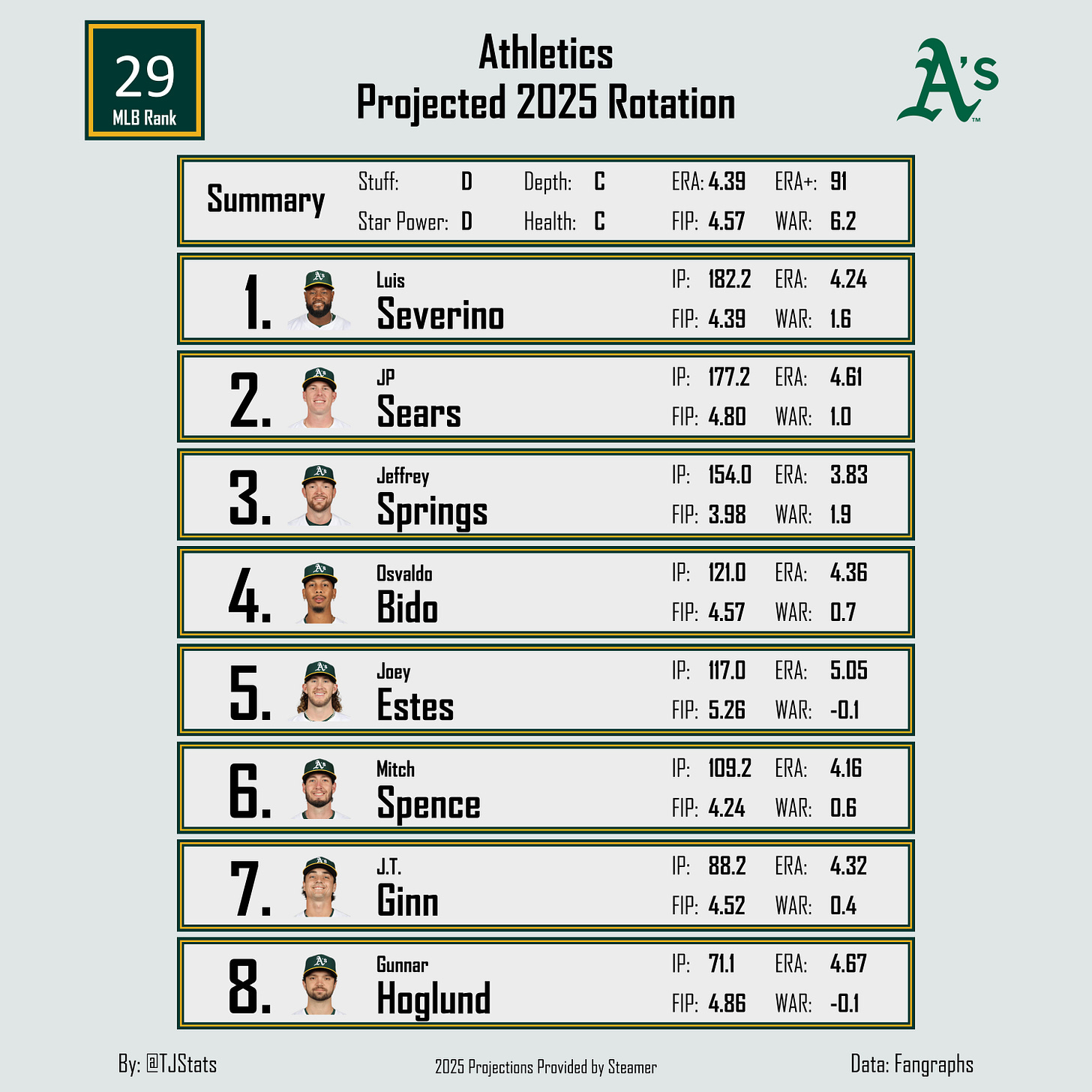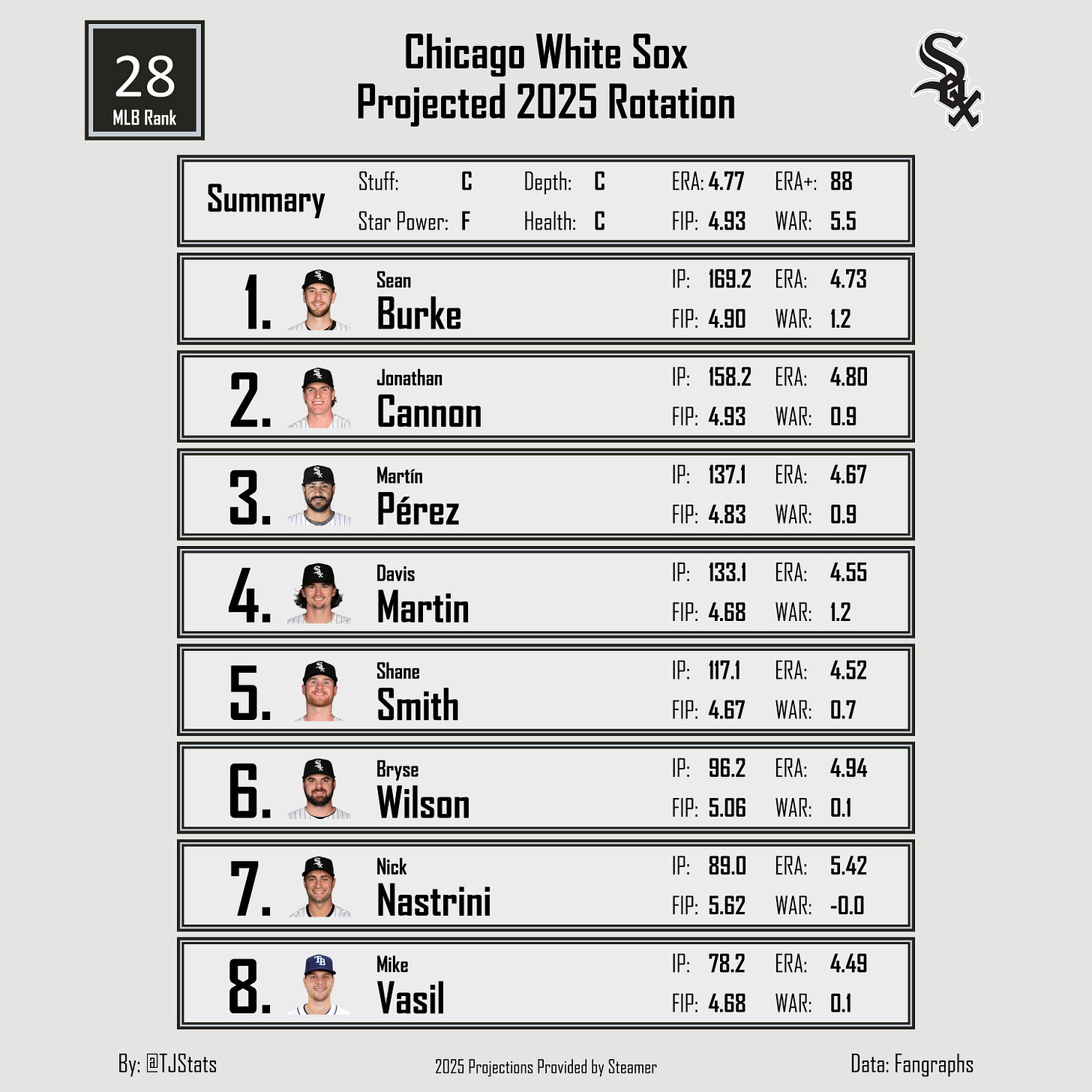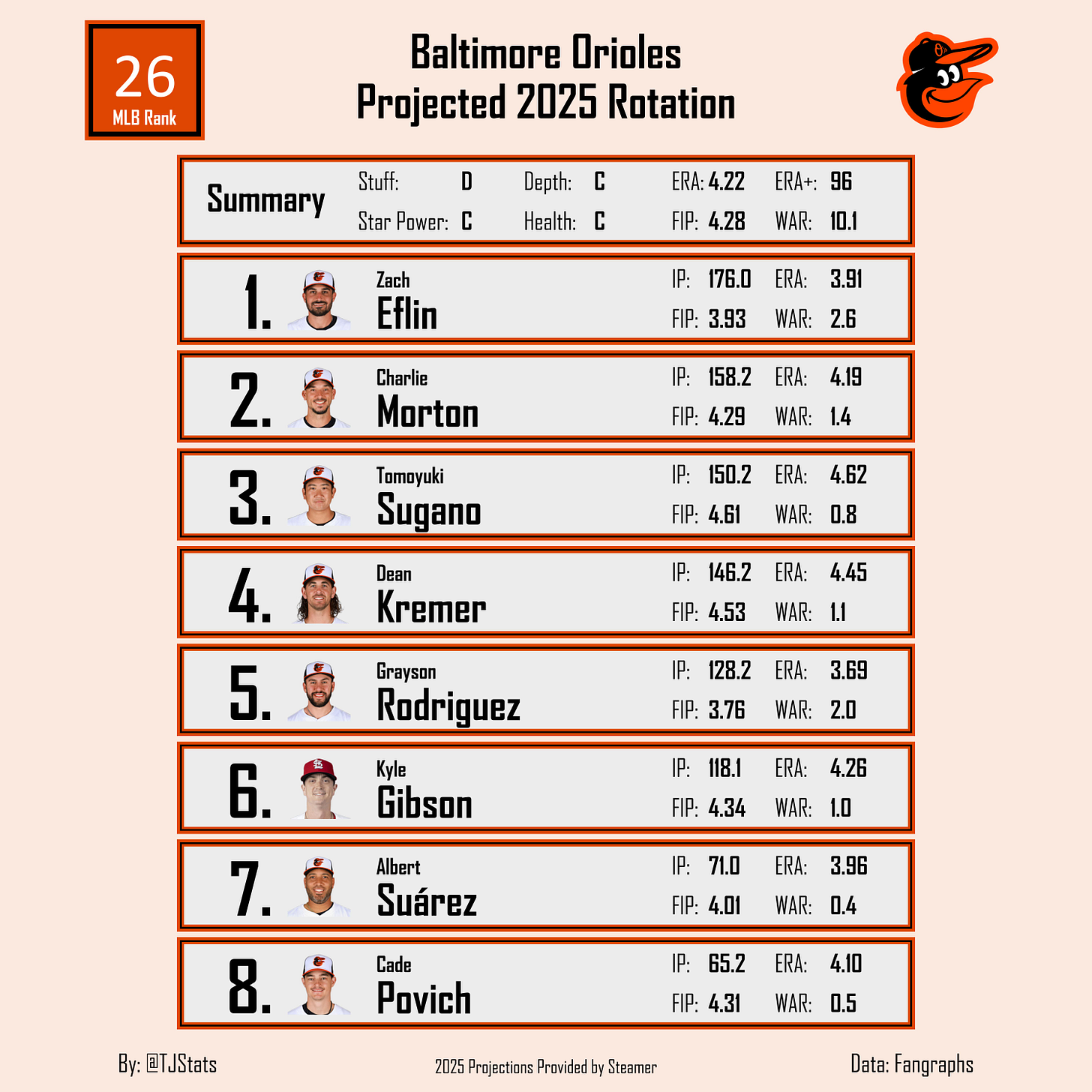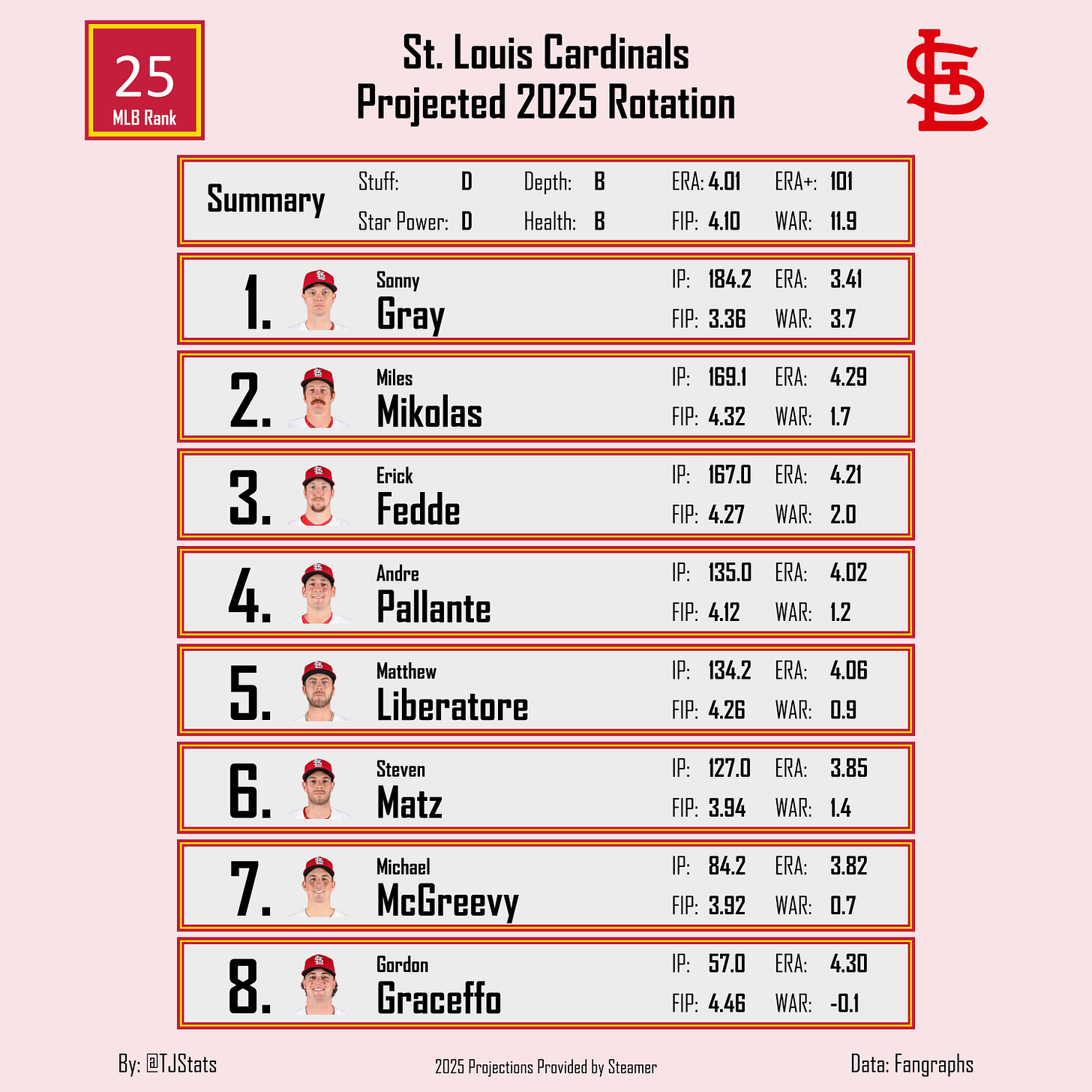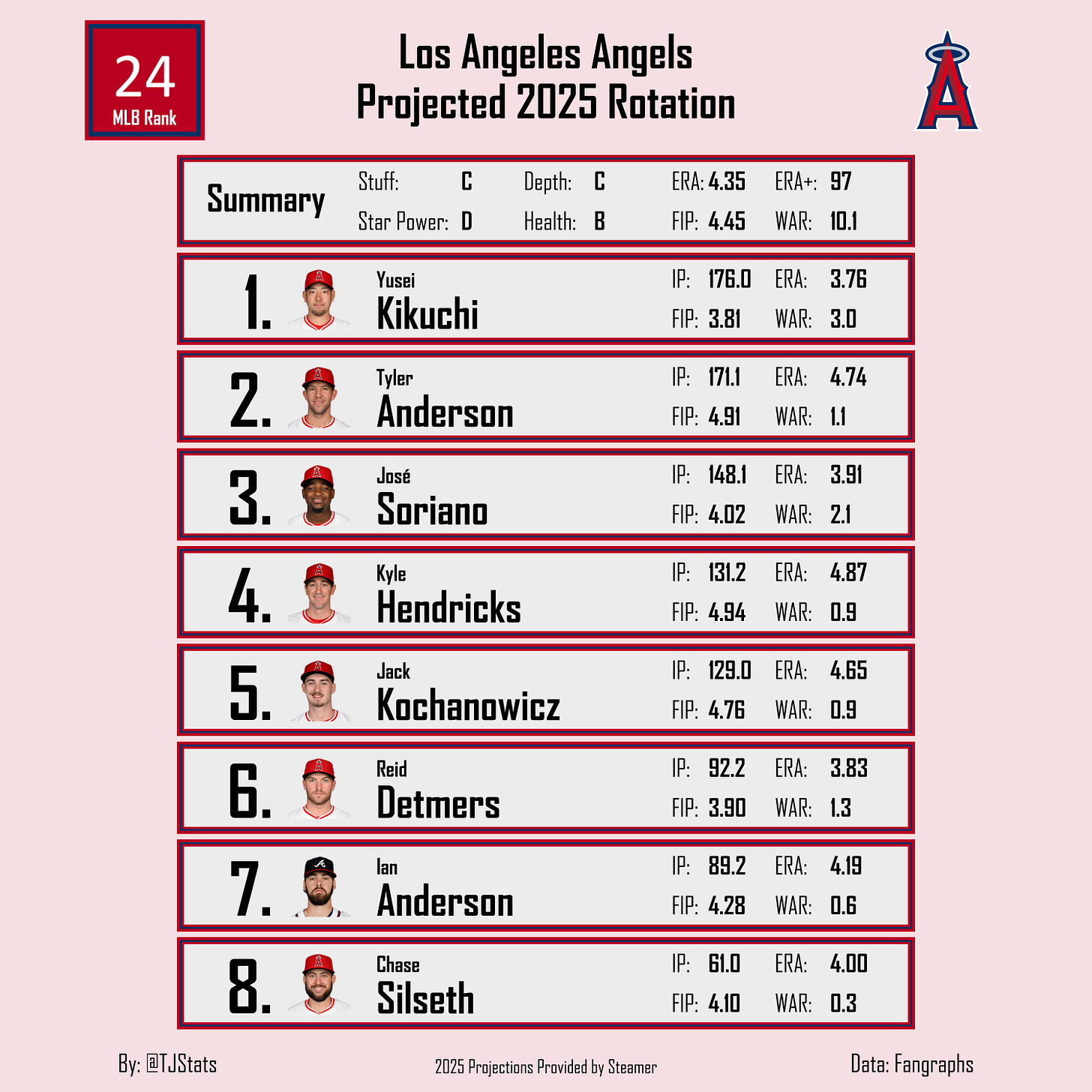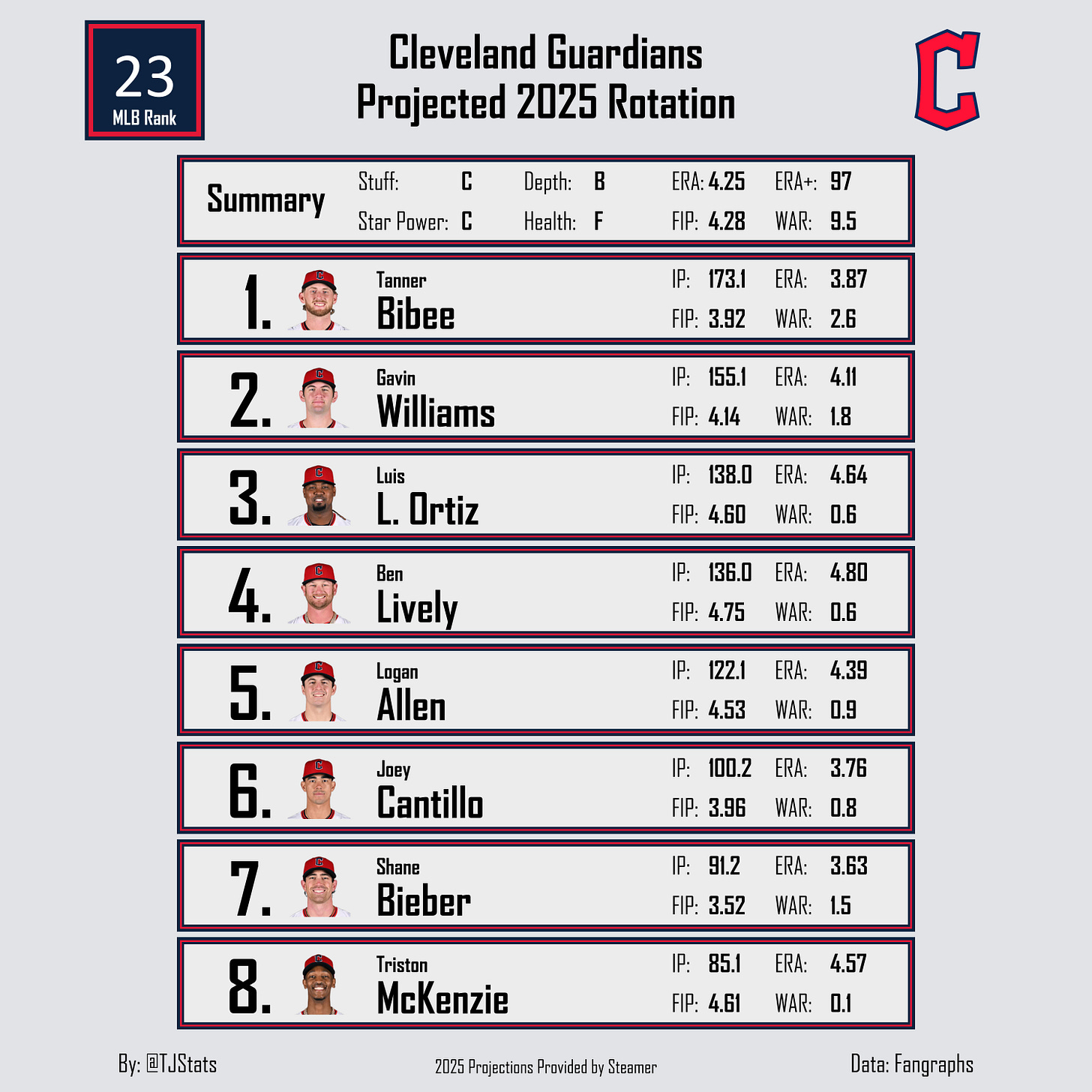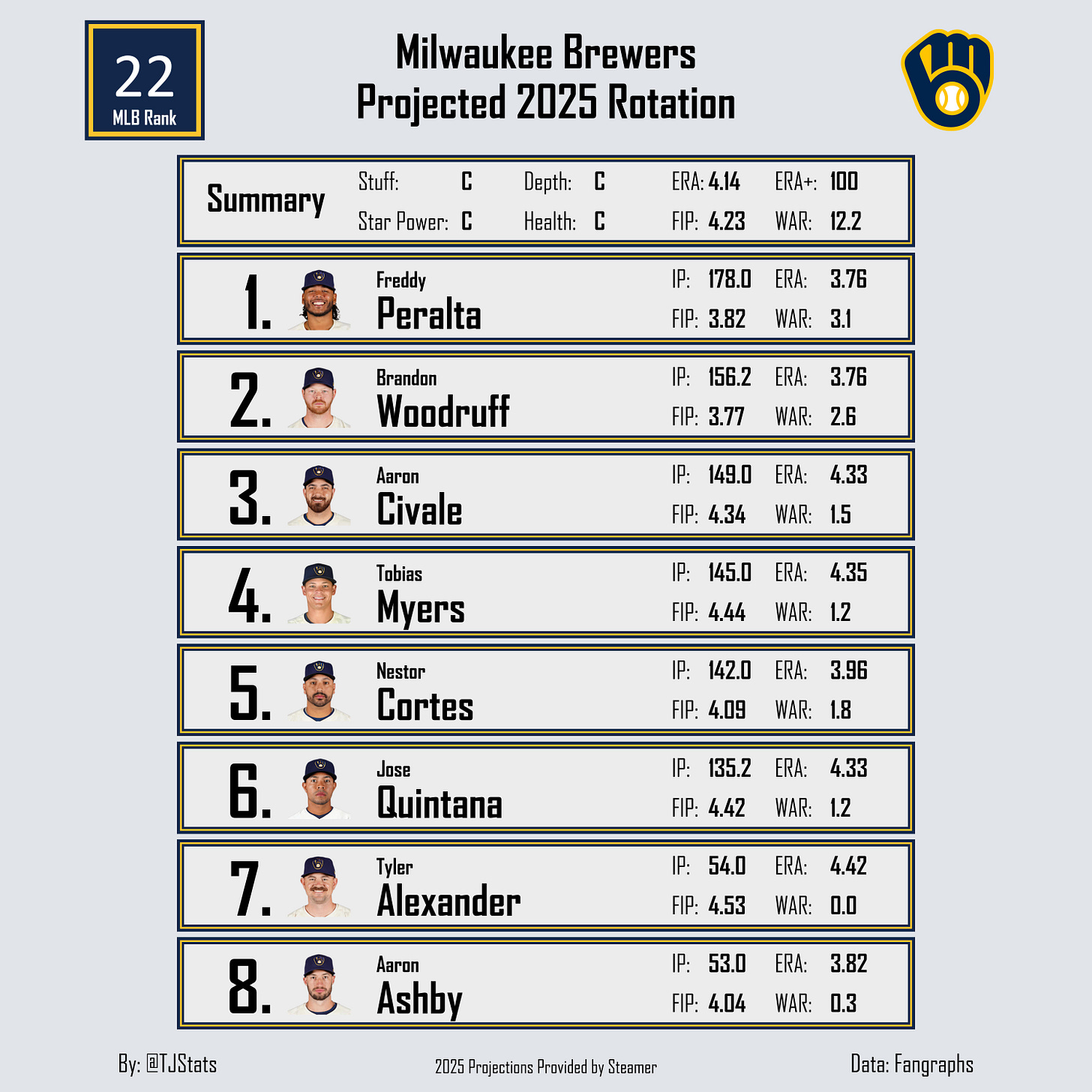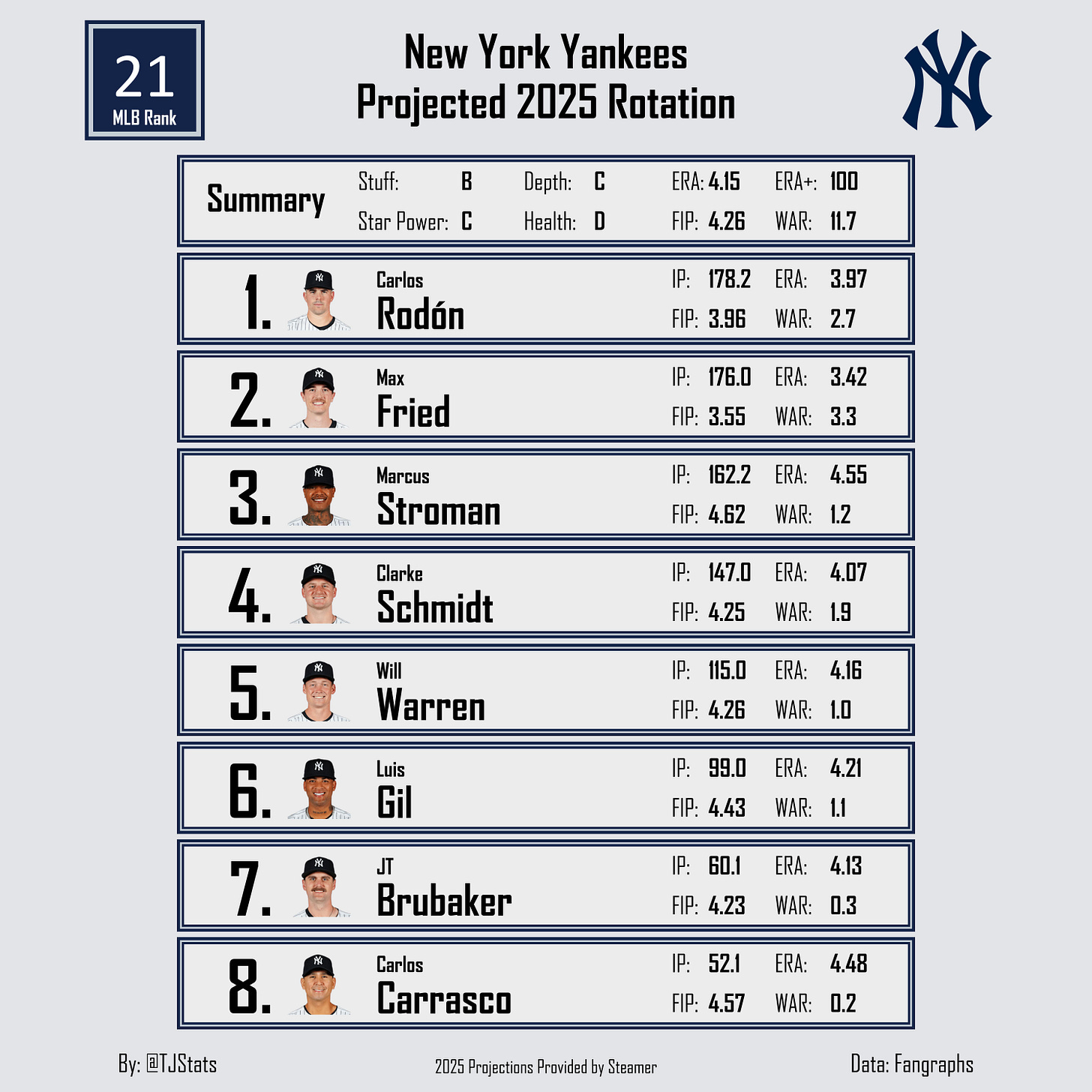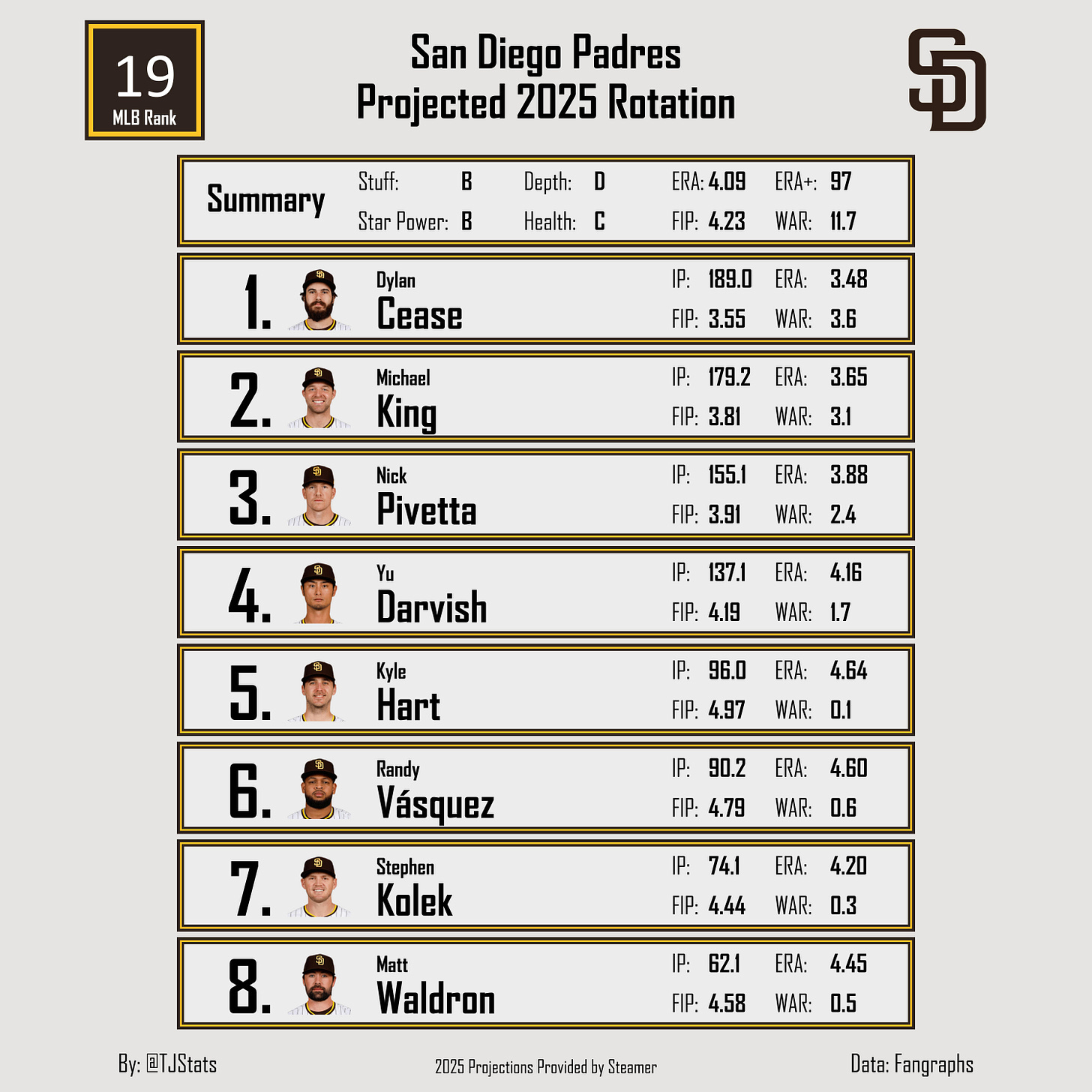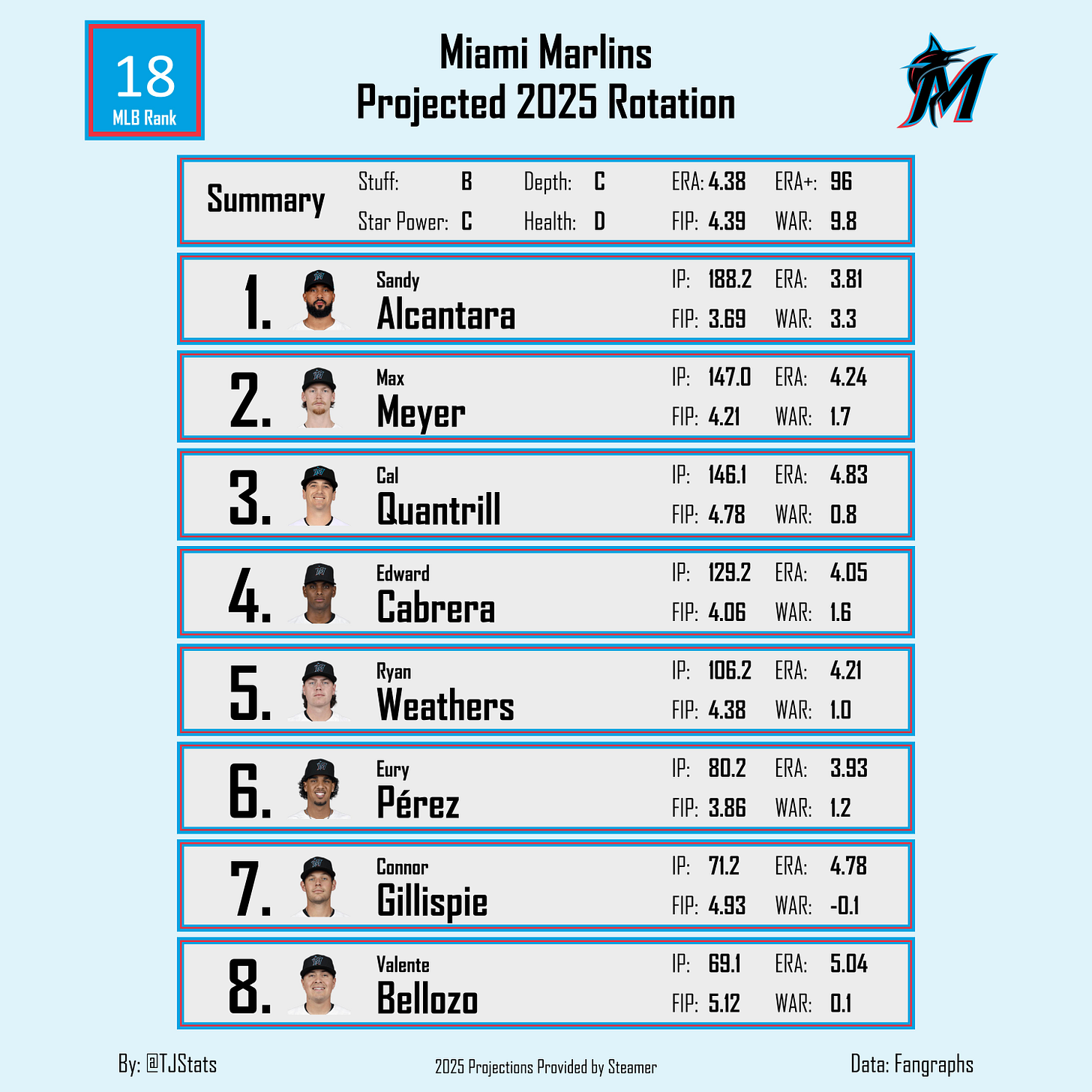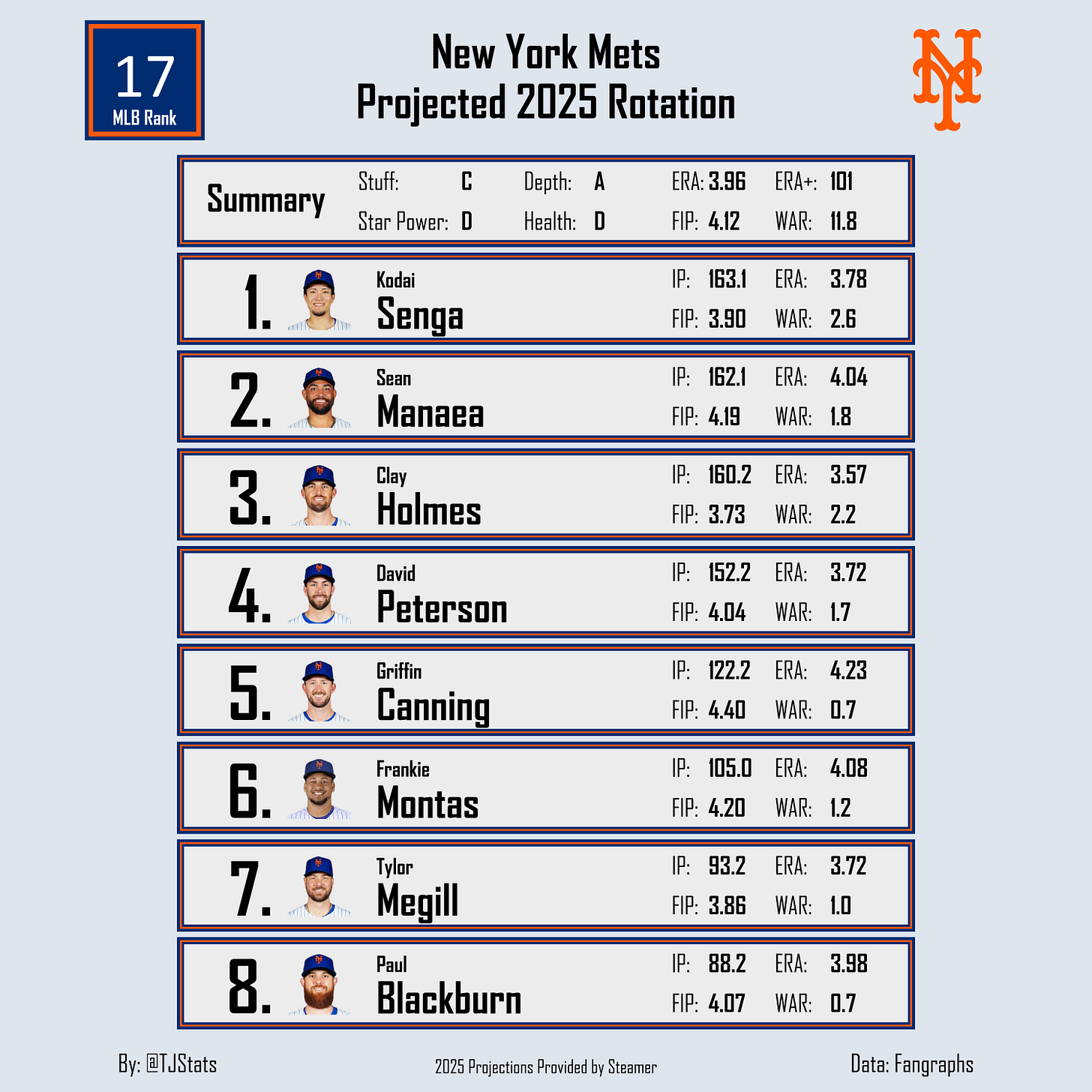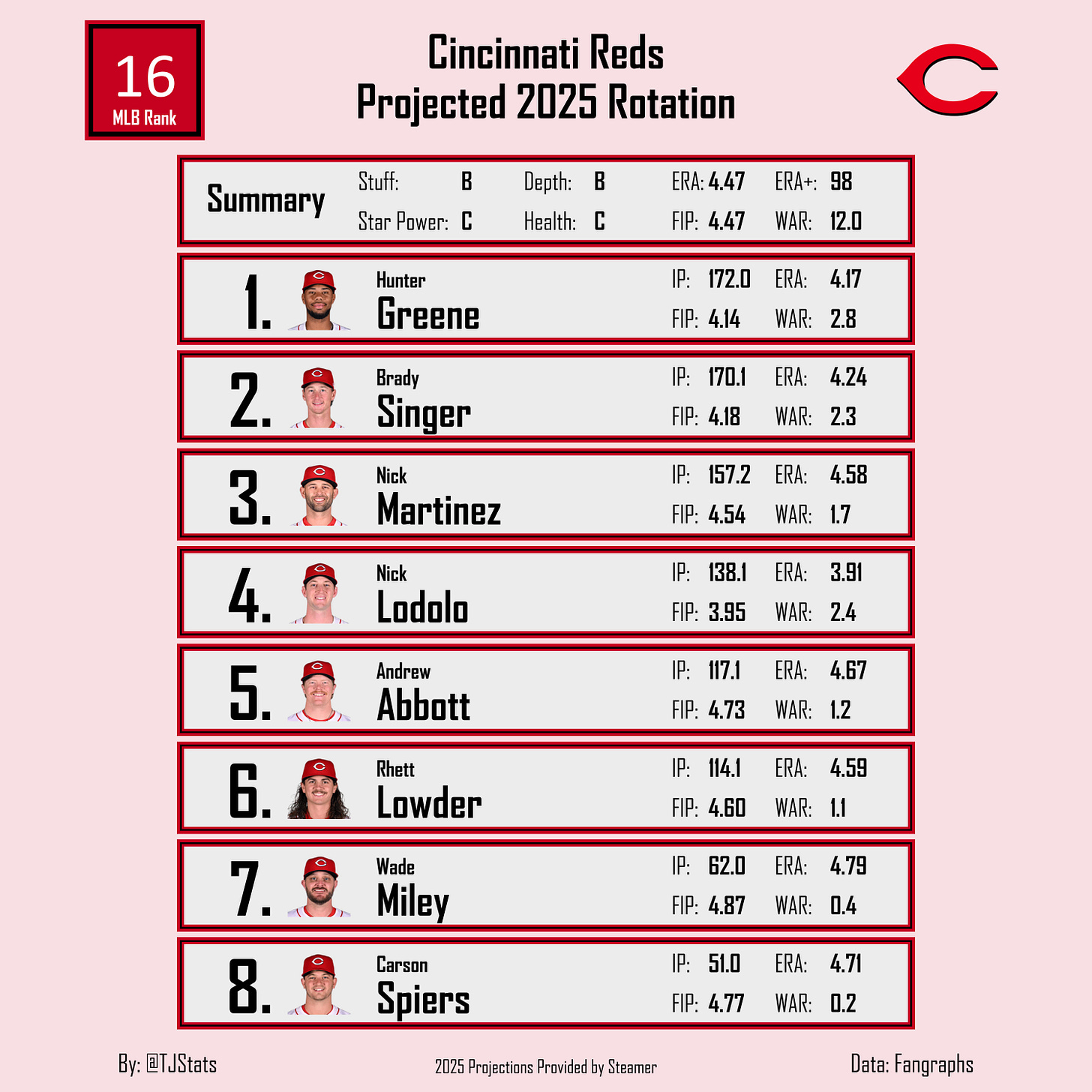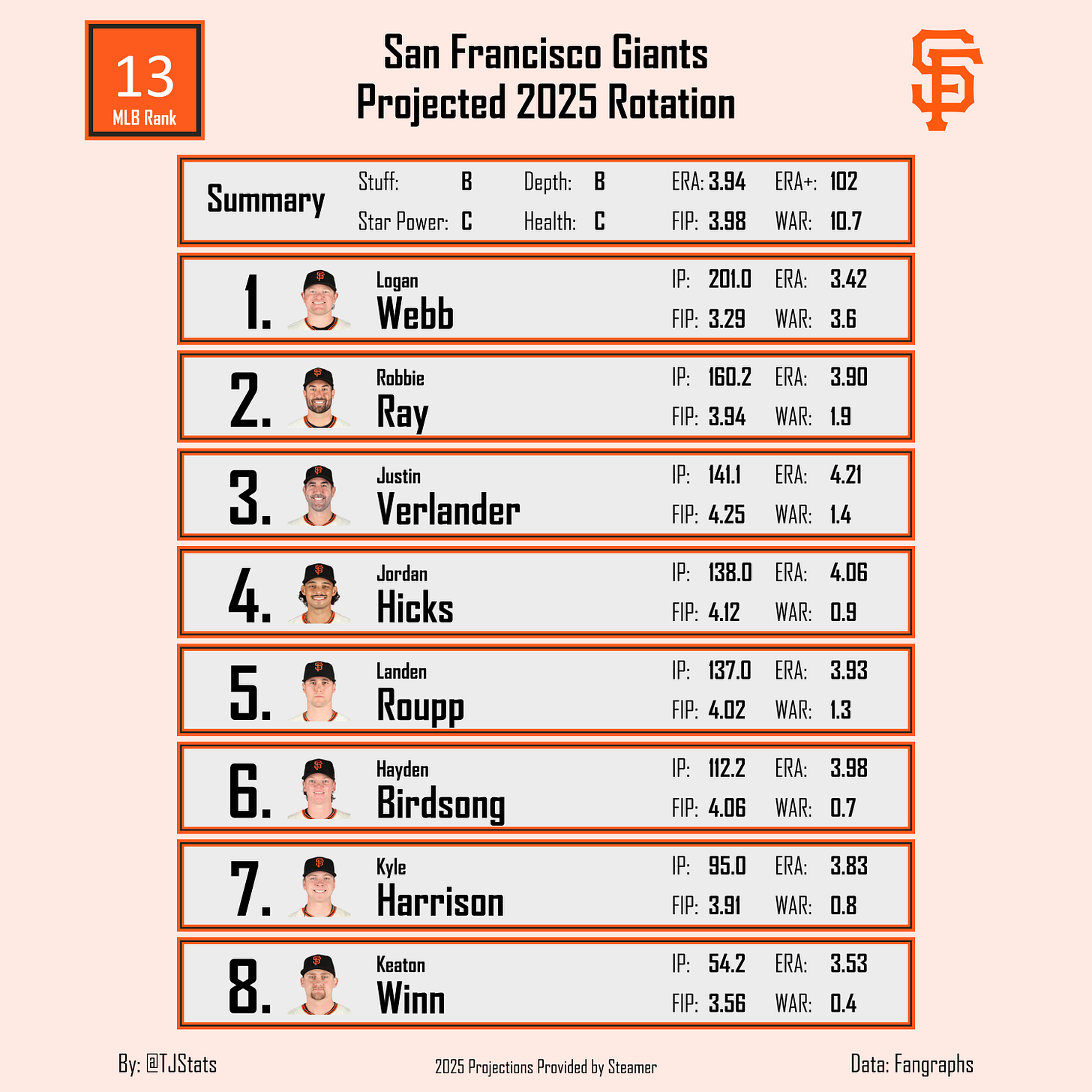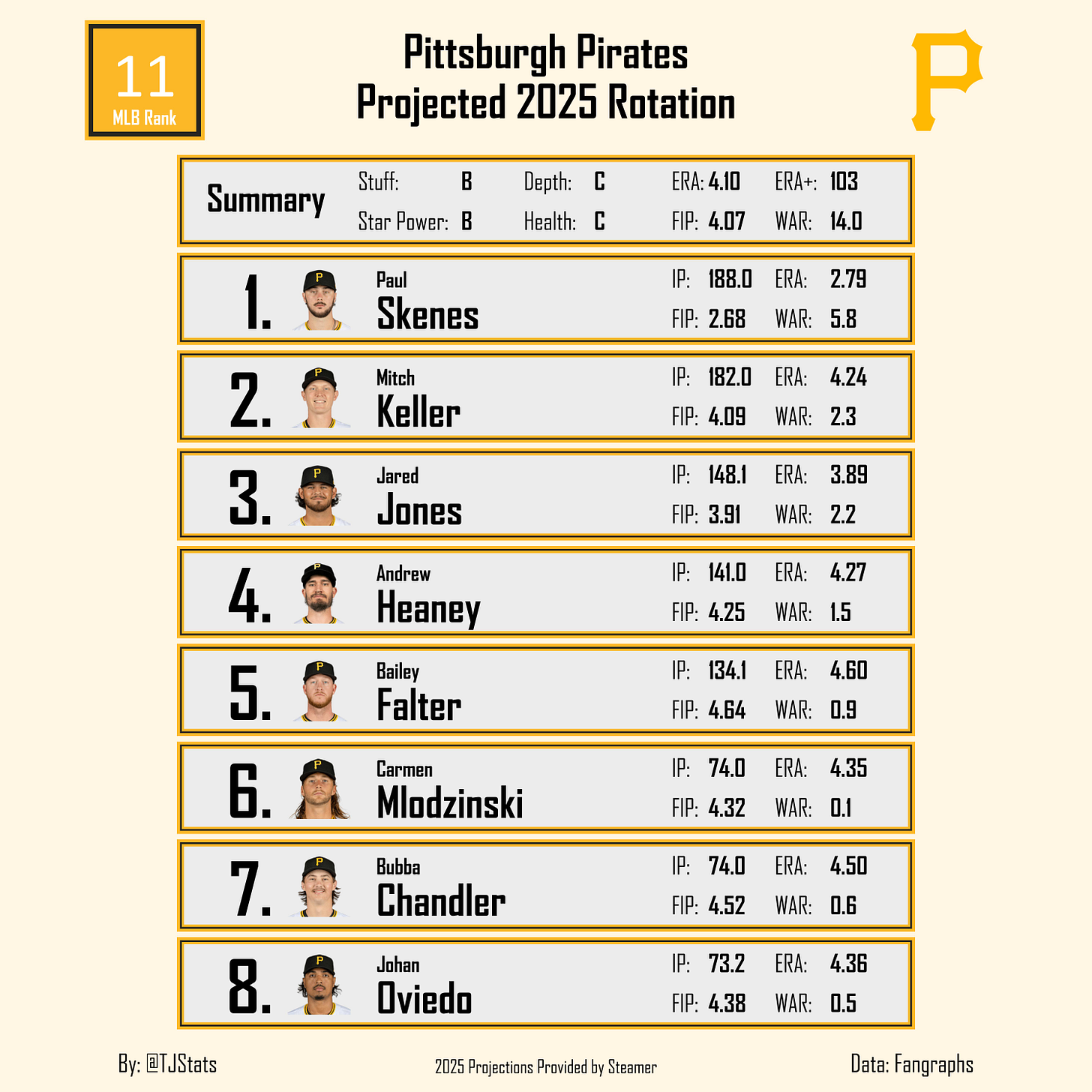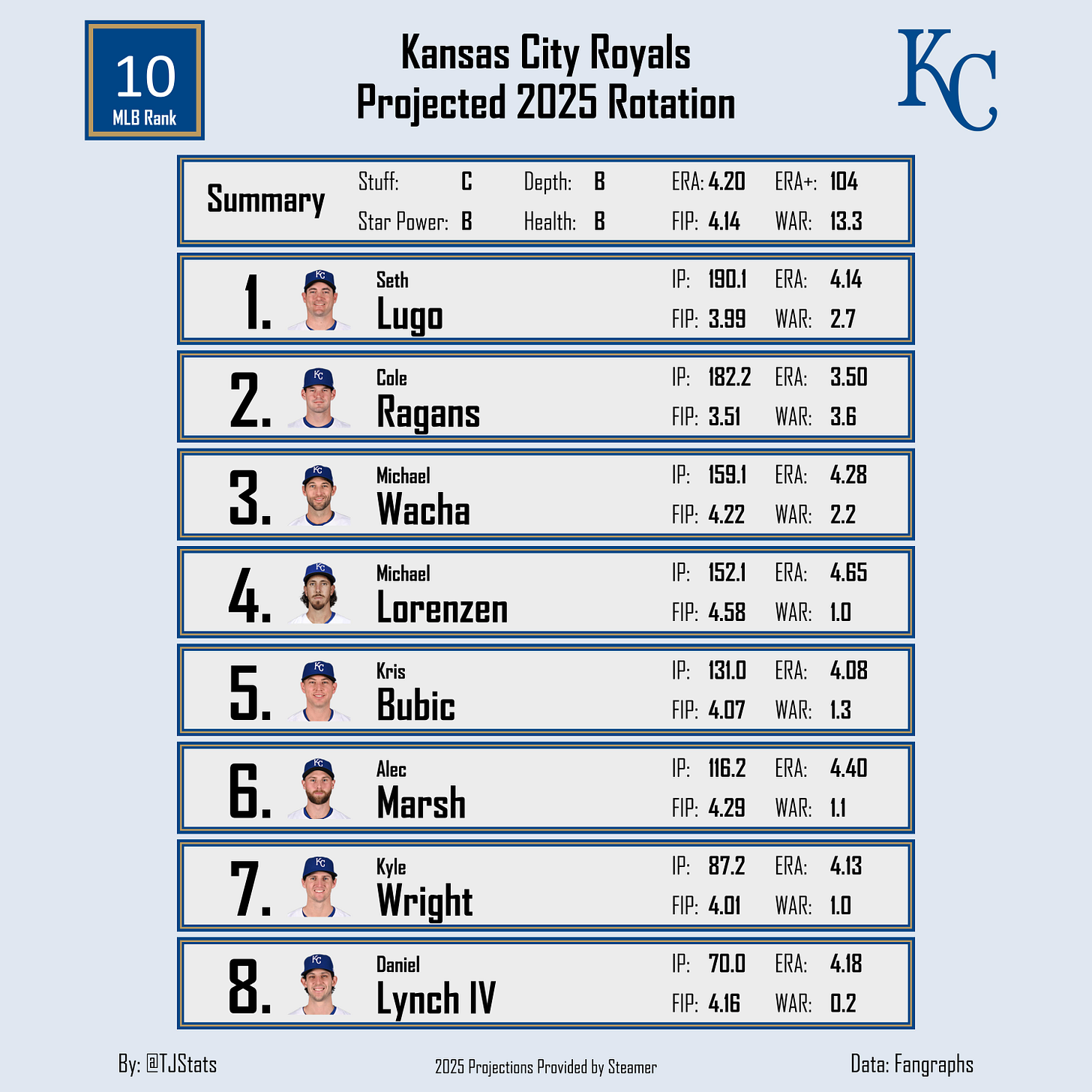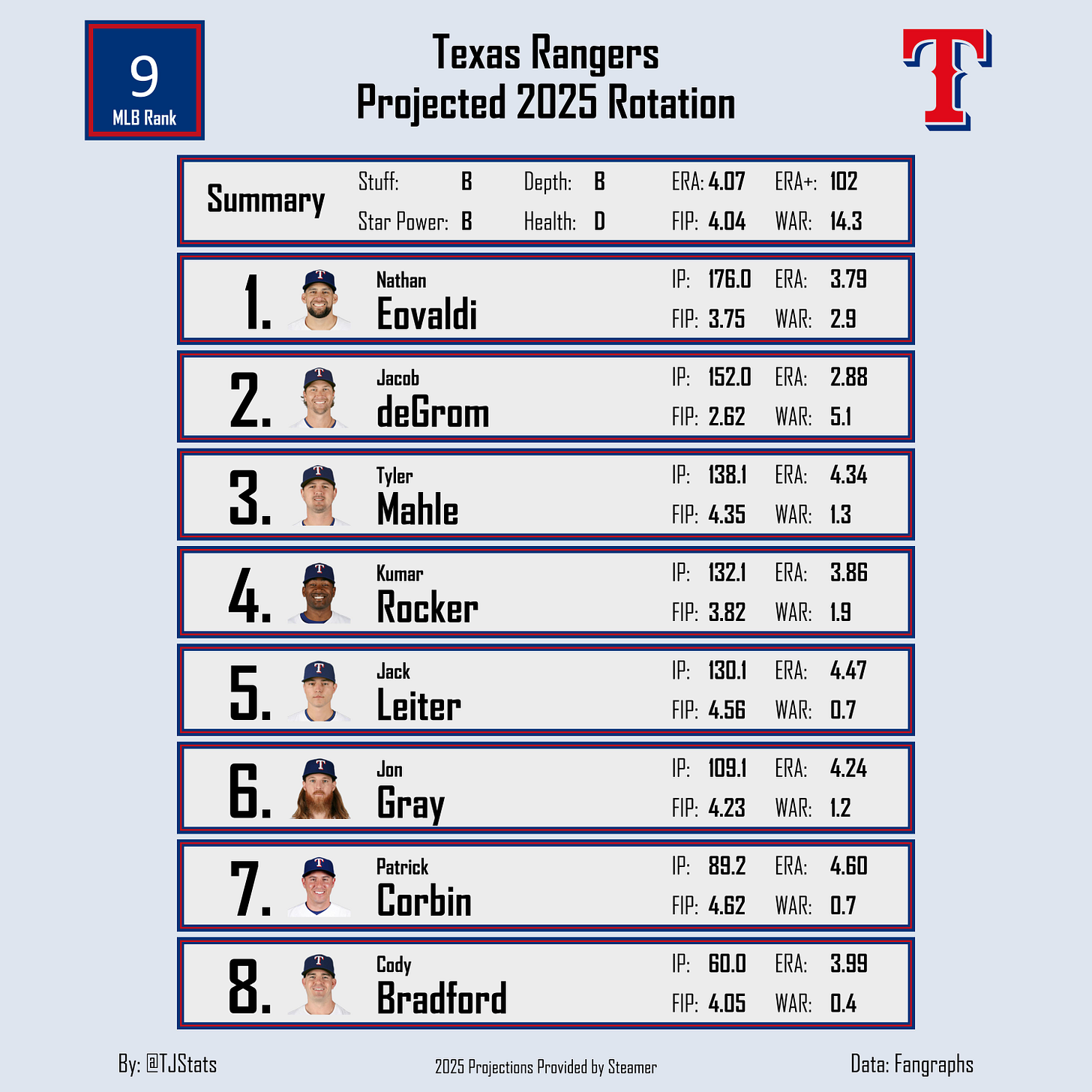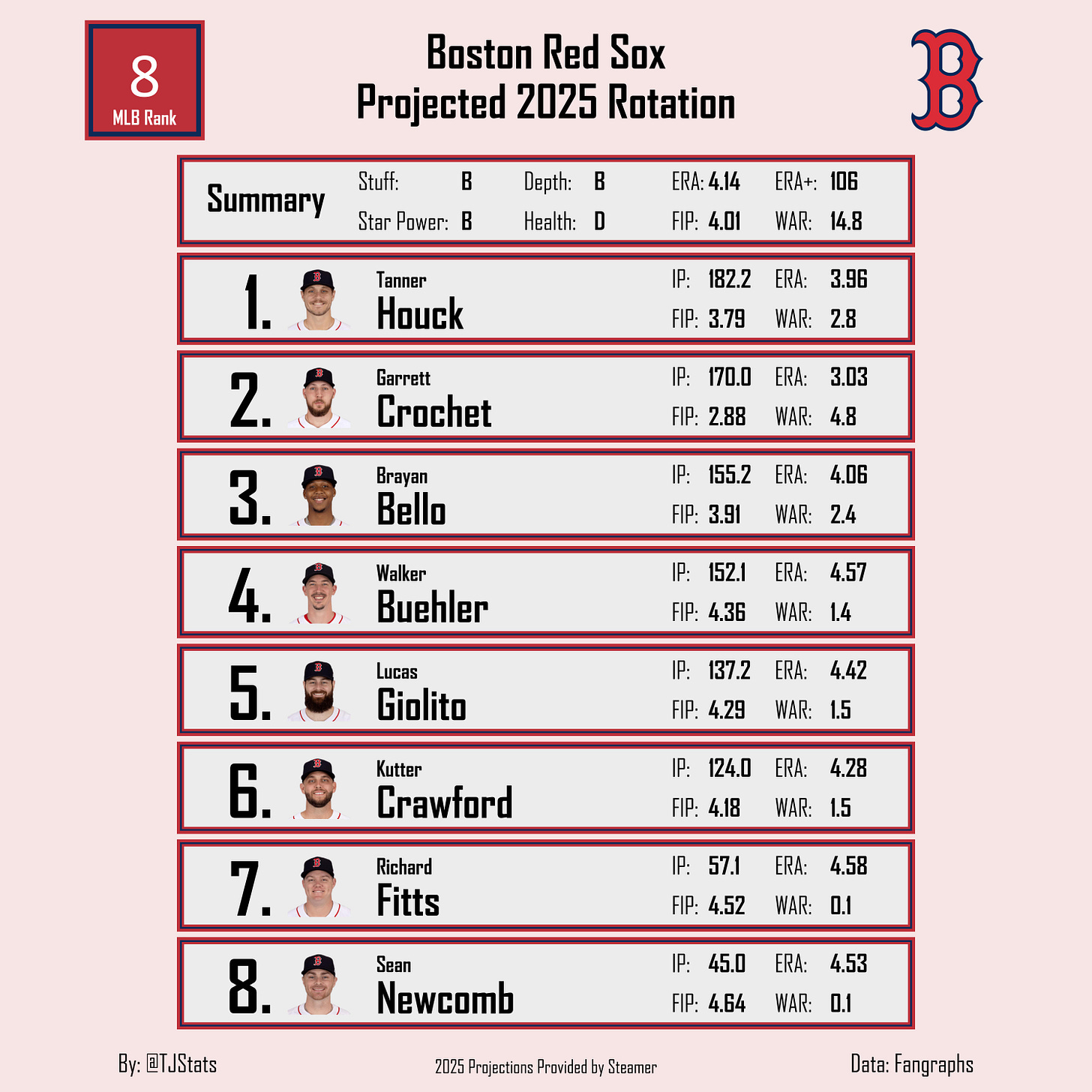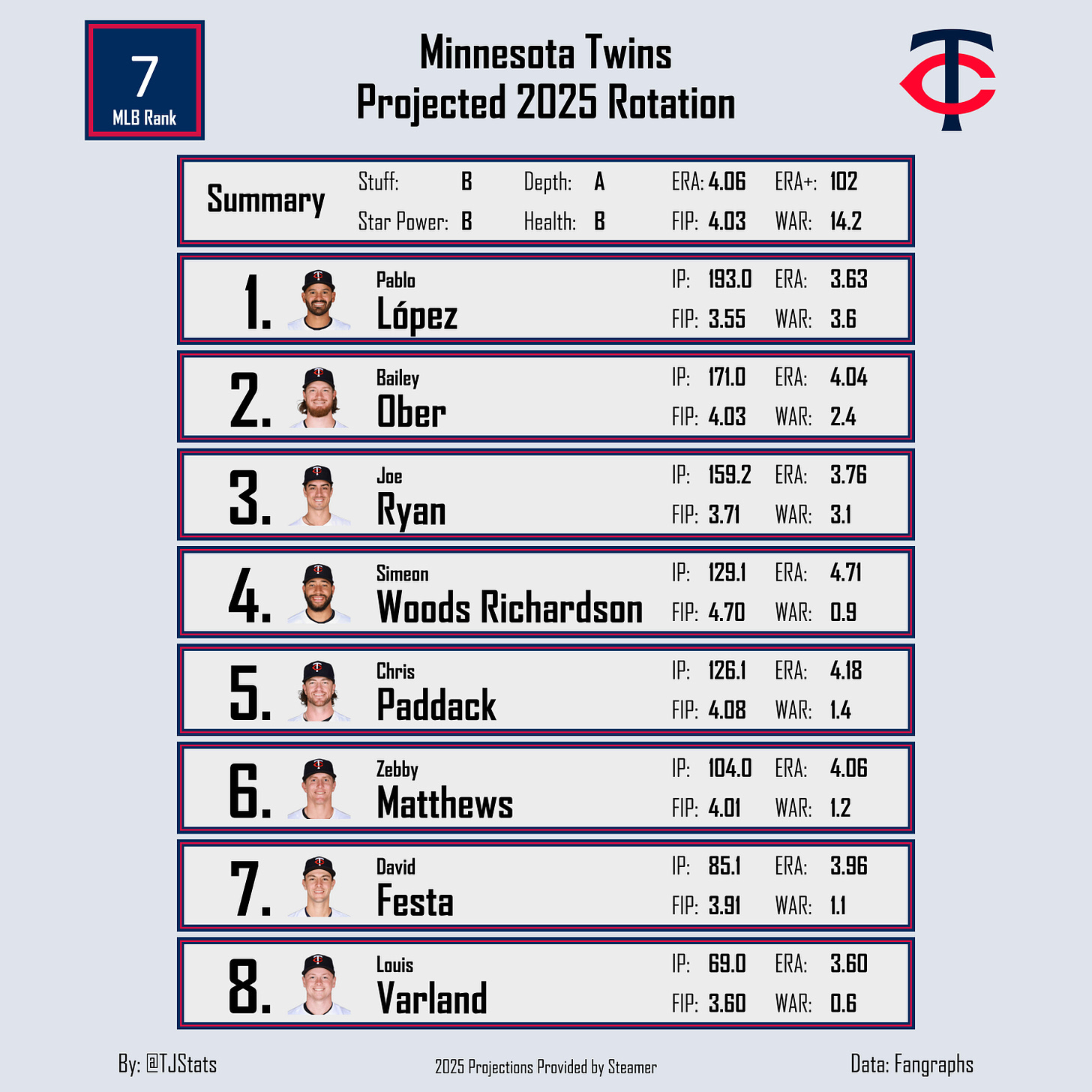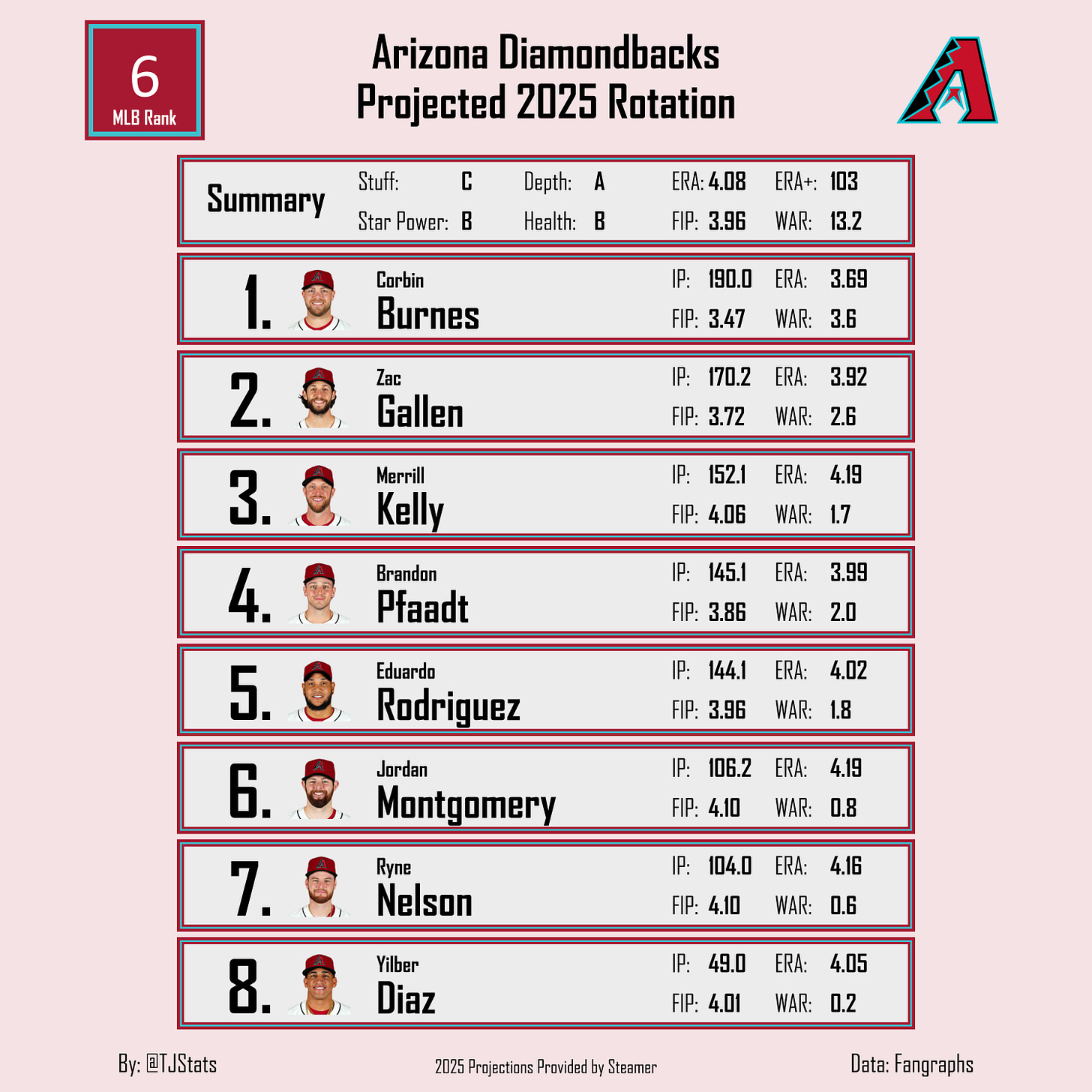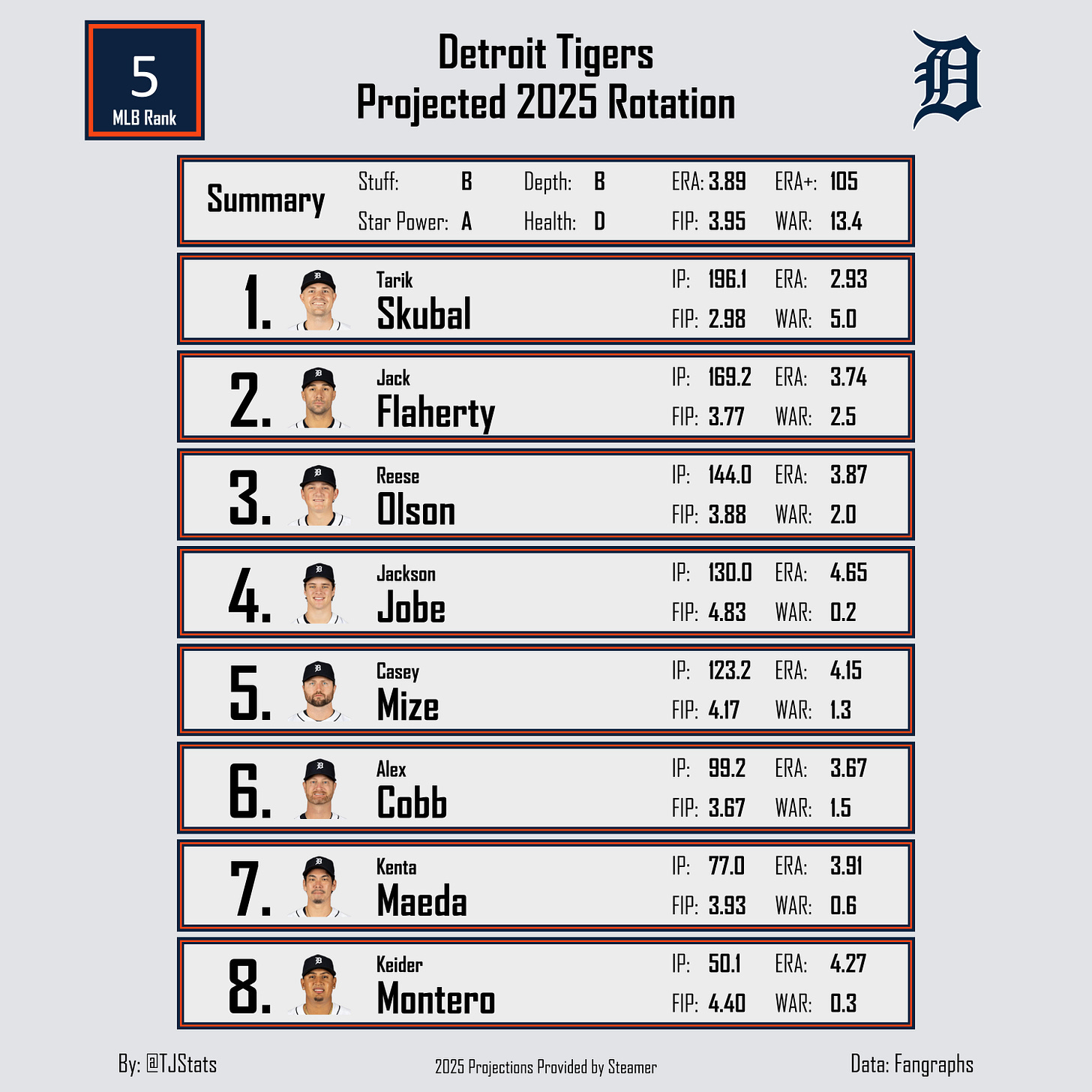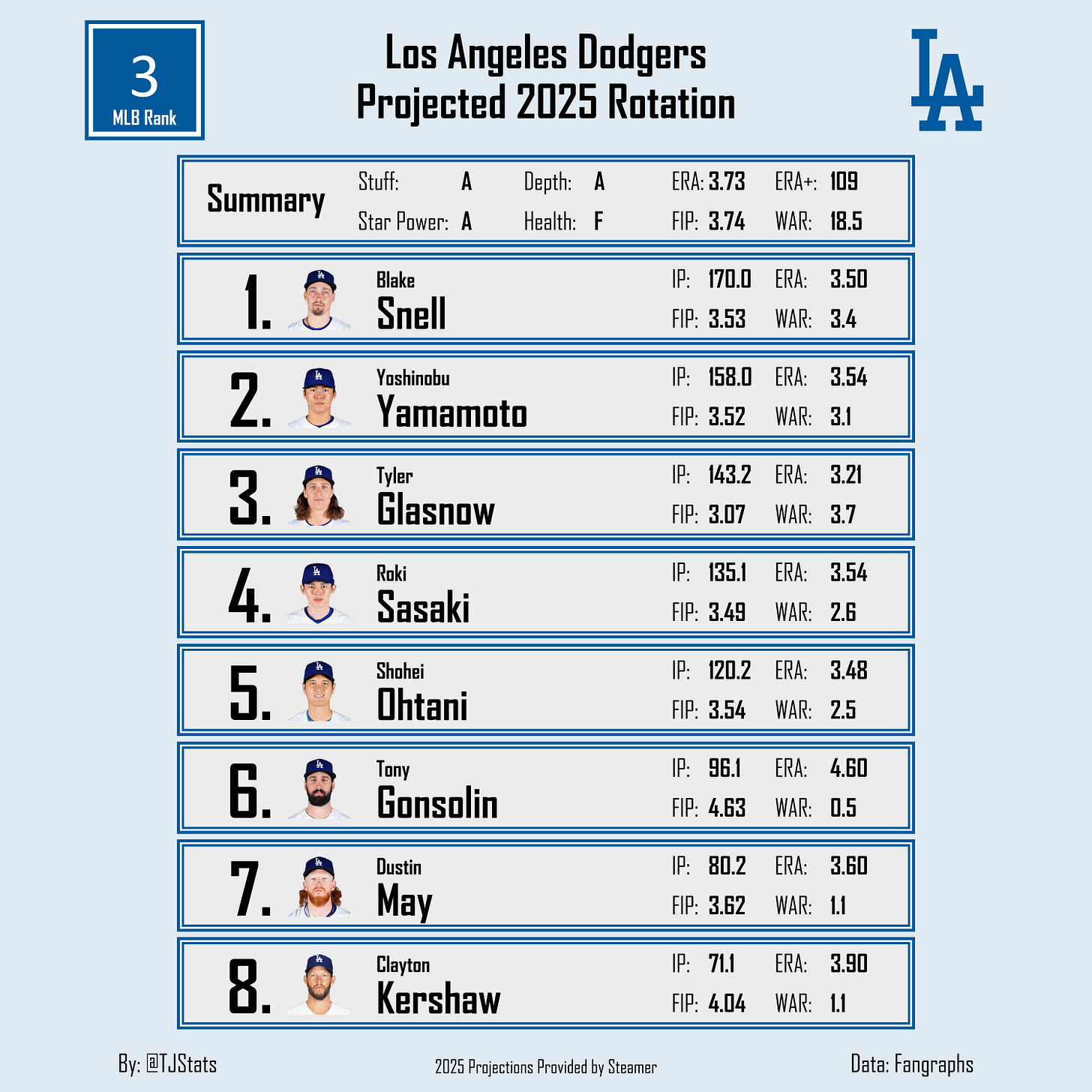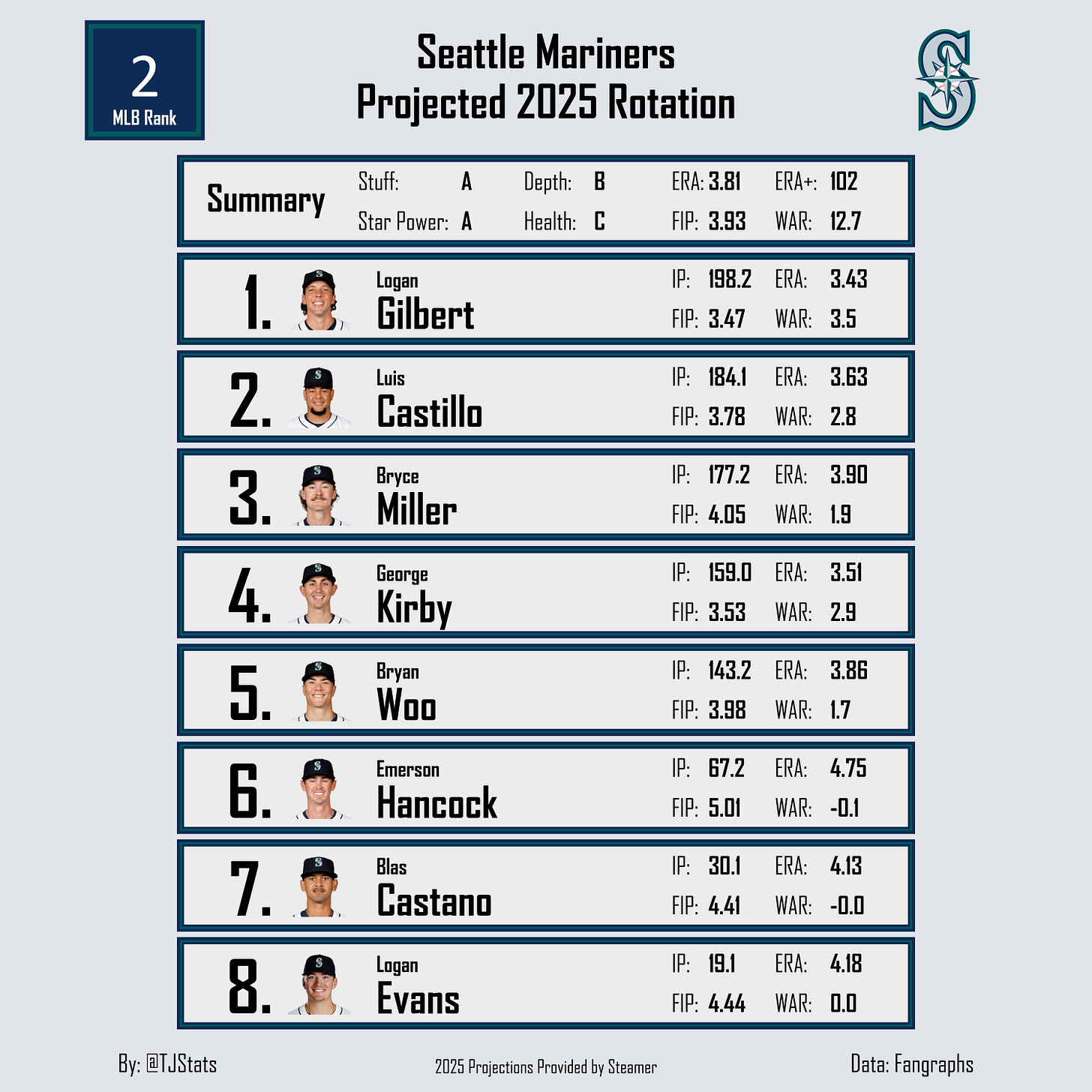Introduction
Rotations are the core of a team’s pitching staff. They are the group of pitchers who are tasked with playing the most innings and are vital to the record of a team over the course of the season. The way each MLB team builds their roster is different, and understanding how they construct their rotations provides a lot of information into how they operate. This was the main driver of why I wanted to rank each team’s rotation. This exercise helped me better understand the structure of each team and helped me refine my analysis when looking at a group of pitchers.
To rank rotations, I graded each team on an A to F scale in the following aspects:
Stuff: Stuff relates to the pitch quality of each rotation. I looked into each feasible starting pitching candidate for each team to better understand their arsenal and the shapes of their pitches.
Star Power: Star power relates to the top of a team’s rotation. I looked at each team’s “Top 3” pitchers and assessed the reliability and upside of that group.
Depth: Depth relates to the overall quality of a rotation and a team’s ability to replace a pitcher. I looked at each team’s set of feasible starting pitcher options and considered their productivity as well as how impactful losing a pitcher would be to their rotation.
Health: Health relates to the ability for the rotation to stay on the field. I considered prior injury history and current ailments.
These aspects were not all considered equally in my rankings. The most impactful aspects were Stuff and Star Power, with Depth coming right after and Health being the least.
With my methodology out of the way, let’s get to the rankings. Enjoy!
Rankings
30) Colorado Rockies
The Rockies rotation is the worst in baseball, and they pitch in the least pitcher-friendly park in MLB. The Rockies refuse to spend money, which puts their rotation in a position to fail every year.
The only redeeming aspect of this rotation is Chase Dollander, who should debut this summer.
29) Athletics
The Athletics (no city for now), to put it lightly, have a rough rotation. They did improve it over the winter with the additions of Luis Severino and Jeffrey Springs, but those moves did not move the needle much. The team lacks high-end stuff and a true ace, which could turn disastrous in their new home park. JP Sears and Mitch Spence are ok backend pieces but project to be below average this season. On top of their mediocre top of the rotation, they don’t have many other options to deepen out their staff.
The Athletics will need to rely on their offence and bullpen to win this season because this rotation is putrid.
28) Chicago White Sox
The White Sox are the worst team in baseball, but I am confident in saying that their rotation is pretty fun. Other than Martin Perez and Bryse Wilson, every other feasible option is a prospect or 2nd-year pitcher that each have the upside to be an everyday starter in MLB. The most notable options to take a big step this season are Sean Burke, Davis Martin, and Shane Smith. Each wields intriguing arsenals and has the stuff to stick in the rotation.
I will say, fun does not mean good. There will be a lot of growing pains, but it will be great to see so many young arms compete for their spot in the Majors.
27) Washington Nationals
I want to like the Washington Nationals rotation. They have a handful of exciting young arms that flashed their upside last season and have the tools to take yet another step in 2025. So why are they ranked this low? It mostly has to do with why I like them; it’s a bunch of young and volatile arms.
MacKenzie Gore took massive strides in 2024, and I expect him to remain an above-average starter this season. Unfortunately, his volatility makes him a worrisome SP1. After Gore, it becomes a hodgepodge of uninteresting and exciting arms. On the boring side, we have Jake Irvin, Mitchell Parker, and Trevor Williams, who would each be solid SP5s on most teams. Unfortunately, they are currently projected to be their SP2, SP3, and SP4 entering the season. These arms pale in comparison to Michael Soroka, DJ Herz, and Cade Cavalli, who each possess strong strikeout ability.
The Nationals rotation has the pieces to be interesting, but their young arms need more seasoning before they become a formidable unit.
26) Baltimore Orioles
It is no surprise that Baltimore is near the bottom of this list. They let Corbin Burnes walk in the offseason and are still without Kyle Bradish as he recovers from elbow surgery. To replace those arms, they signed soft-tossing Japanese righty Tomoyuki Sugano, 41-year-old Charlie Morton, and Kyle Gibson. On top of all this, Grayson Rodriguez will miss at least the first few weeks of the season with an elbow injury.
In its current state, Zach Eflin is their ace, and that simply is not good enough for a World Series contender. It is not all negative, though. The Orioles have a fair bit of depth to help mitigate the lack of star power in their rotation. Cade Povich, Chayce McDermott, and Brandon Young are all near Top 100 prospects on their 40-man roster. If at least one of them clicks this season, it will put Baltimore in a much more favourable spot. In addition to their prospects, Albert Suarez has proven he can be a reliable spot starter.
Baltimore’s lack of spending to support their elite offence is a perplexing situation that reeks of cheap ownership.
25) St. Louis Cardinals
Sonny Gray is doing the heavy lifting for the Cardinals rotation. The veteran righty posted the best K-BB% of his career last season, which lines him up favourably entering 2025. Erick Fedde had a strong 2024 in his return from Korea and is projected to be effective once again. After Gray and Fedde, the flaws in the Cardinals rotation come to light. Miles Mikolas and Steven Matz were ineffective during 2024, and their contracts will likely keep them in St. Louis for most, if not all, of this season. Adam Pallante and Matthew Liberatore will each be given a chance to stick in the rotation to start the season, but do not project to be more than a backend starter.
The Cardinals depth is where they get back on track. Their top prospect, Quinn Mathews, is expected to debut this season, while they also have a handful of other prospects raring to go, like Michael McGreevy and Tink Hence.
Overall, St. Louis has an uninteresting rotation without the stuff to prop it back up.
24) Los Angeles Angels
The Angels bolstered their rotation this winter with the addition of Yusei Kikuchi and Kyle Hendricks, with the former being a good move in my eyes and the latter being a big question mark. Tyler Anderson had an effective 2024, but his poor stuff and inability to rack up strikeouts leave him susceptible to a big dose of regression. With those 3 spots locked up, the Angels will turn to a medley of young arms to round out their rotation. Jose Soriano is a lock for the rotation and has the tools to be the most valuable pitcher on the team. This leaves Reid Detmers, Jack Kochanowicz, and Caden Dana as the remaining options for the #5 spot. Jack Kochanowicz was awarded the first chance in the rotation with Detmers starting the season in the bullpen and Dana waiting in the wings in MiLB. The recent claim of Ian Anderson gives the Angels some more SP depth to work with throughout the season.
The Angels are at least another year away before their cavalry of pitching prospects can make an impact in the Majors. In the meantime, their rotation is littered with uninspiring arms with a few interesting pieces mixed in.
23) Cleveland Guardians
Amongst playoff teams, Cleveland by far had the worst rotation in MLB last season. They were decimated by injuries, with the most impactful being Shane Bieber after his incredible start. Their depth couldn’t handle the loss of their best arm, and their remaining pitchers struggled to find their groove.
Contrary to last season, their depth looks like one of the strongest parts of their rotation. Their rotation is headlined by two exciting arms in Tanner Bibee and Gavin Williams with a handful of decent pitchers to munch up innings. Luis L. Ortiz and Ben Lively don’t light up projection models but were both effective last season in starting roles. Joey Cantillo is my favourite of the bunch thanks to his elite extension and strong secondaries, but he will start the season in AAA with Logan Allen recently announced to be in the rotation.
I would be remiss to not mention that injuries are still a big concern. Shane Bieber is expected back this summer, but it is always unclear when dealing with elbow injuries. Additionally, Triston McKenzie and Gavin Williams have each had their own fair share of injury scares in recent years.
Cleveland’s rotation seems better this season, and that might be all they need to allow their dominant bullpen to close out games.
22) Milwaukee Brewers
The Brewers have a fully stocked rotation this year, but none of it screams of very high upside. Freddy Peralta has struggled with inconsistencies over the past few seasons, and Brandon Woodruff is making his long-awaited return to the mound following shoulder surgery. After their top arms, their rotation relies on a ton of depth to get through the required innings. Tobias Myers, Nestor Cortes, Aaron Civale, and Jose Quintana each have their own quirks, which make them reliable backend options.
The big concern I have with the Brewers rotation is injuries. Woodruff and Myers are out for the start of the season, which already forces Milwaukee to dip into their depth. The most notable remaining arms are Tyler Alexander, Aaron Ashby, and Logan Henderson.
The Brewers rotation is the weakest aspect of their team and could spell trouble as they look to repeat as NL Central Champions.
21) New York Yankees
No team has seen their rotation crumble more than the Yankees this spring. Gerrit Cole’s season-long absence sparked a ripple effect that exposed the Yankees lack of depth, and they are now scrambling to fill in the innings. Injury concerns also surround the Yankees as Luis Gil and Clarke Schmidt will miss the start of the season while Max Fried and Carlos Rodon have struggled with staying on the field in the past. After those 4 arms, the rotation becomes cloudy. Marcus Stroman is the most reasonable option due to his workload ceiling and contract, but his impact shouldn’t be more than an SP5. Both Carlos Carrasco and Will Warren will start the season with the Yankees to fill out their ailing rotation.
The Yankees rotation will have to scour for innings to start the year but should have a more exciting group once Gil and Schmidt join the fray. For now, it’s a low-upside rotation with a solid core at the top and an assortment of supporting pieces filling in the newly formed holes.
20) Toronto Blue Jays
The Toronto Blue Jays rotation is a mishmash of veteran arms that each do everything well, but nothing outstanding. They leaned even harder into this archetype with the addition of Max Scherzer, who enters 2025 in his age 40 season. The most impressive aspect of the Blue Jays rotation is their ability to stay on the field. Kevin Gausman, Chris Bassitt, and Jose Berrios have only missed a handful of starts combined since 2020 and provide a very stable floor to an otherwise low-upside rotation.
Bowden Francis feels like the crux of their pitching staff. His 2024 2nd half was fueled by his ability to induce weak contact and limit base runners. It will be difficult buying into a starter without jaw-dropping stuff to remain productive while allowing a lot of batted balls. After Francis, the depth quickly dissipates with Yariel Rodriguez and Jake Bloss as the next men up. At this stage, Rodriguez is simply a spot starter, and Bloss needs more refinement in AAA.
The Blue Jays do have a secret weapon, though. Well, it is not a secret, but they enter 2025 as back-to-back team gold glove winners and found a way to improve their defence with the addition of Andres Giménez. Elite fielders make pitchers better and should help buoy the Blue Jays rotation to the middle of the pack.
19) San Diego Padres
Dylan Cease and Michael King give the Padres one of the best 1-2 punches in MLB, and they bolstered their rotation with the addition of Nick Pivetta. Yu Darvish will start the season on the IL with an elbow injury, but his seemingly never-ending arsenal makes him a formidable backend option for a team lacking depth. As for their #5 starter, the Padres really don’t have one. Kyle Hart is back from Korea, where he was a dependable innings eater; however, projections paint him as a simply replacement-level arm. Their remaining options are a bit more interesting in Stephen Kolek, Matt Waldron, and Randy Vasquez, but they do not spark much joy for a team planning to make a run for the playoffs.
The Padres will have solid pitching every 4/5 days, but that 5th day is what prevented me from ranking them any higher. Any injuries pose a massive issue that their depth cannot compensate for.
18) Miami Marlins
Spring Training has done wonders for my perspective on the Marlins rotation. Sandy Alcantara looks back to his Cy Young form while Ryan Weathers and Max Meyer look like completely new pitchers. The wild Edward Cabrera and his disgusting changeup will be relied upon to eat a bunch of innings, but he will start the season nursing a blister. Cal Quantrill was a necessary addition, as he gives the Marlins a reliable #5 option.
I am most interested to see how Weathers and Meyer adapt throughout 2025. They have seriously impressed me this spring, and each looks the part of future mid-rotation starters as soon as this season. Weathers is unfortunately out for 4-6 weeks as he tends to a forearm strain. I am also patiently awaiting the return of Eury Perez, who is working his way back from Tommy John surgery.
The Marlins will rely on their top 3 starters to carry most of the load this season with a medley of auxiliary arms to fill in the gaps. I am buying into the Marlins new pitching development team and expect them to perform better than their projections.
17) New York Mets
The Mets rotation strength comes from their depth. They have 8 MLB-quality starters, and we have already seen the depth come to the rescue following a couple of injuries to Sean Manaea and Frankie Montas. The biggest hindrance to their productivity is the lack of high-end talent. Kodai Senga is their #1, but an injury-riddled 2024 and shaky playoffs have killed a lot of hype around the Japanese righty. Projections project him as a solid 2/3 option, which leaves an ace-sized hole in their rotation.
Clay Holmes will be leaned on a lot to bolster their rotation, and he has the stuff to do so. I really like what I have seen from Holmes this spring, but there will surely be growing pains and potential innings restrictions as he ventures off into his first full MLB season as an SP. The rest of the Mets pitching staff is comprised of backend starters that have the potential to buoy the Mets rotation into the top half of the league.
In their current state, the Mets have a lot of options to work with when everyone is healthy. We know how important depth is, and the Mets have some of the best in MLB.
16) Cincinnati Reds
Cincinnati starts every season with a big disadvantage because Great American Ballpark is a hitter’s paradise. With their moves over the offseason, it seems like the Reds are formulating a rotation that can survive and thrive in GABP. The addition of Brady Singer and his above-average groundball-inducing abilities should help mitigate home runs. They also retained Nick Martinez, who was one of the best pitchers in MLB when it came to limiting hard contact and barrels. The rest of their rotation features fireballer Hunter Greene, who broke out in a big way last season, and a pair of lefties who are still looking to take that next step in Andrew Abbott and Nick Lodolo.
Top prospect Rhett Lowder is an excellent #6 option, with Wade Miley and Carson Spiers being solid depth if required. It might be a long shot, but Chase Burns and his game-breaking stuff could be an option once the summer comes around.
The focus on damage mitigation limits the upside of the Reds rotation, but it lines them up for a decent season in their hellish park.
15) Chicago Cubs
The Cubs are consistently in the middle of the pack each season in terms of their rotation, so it felt right to slot them in at #15. Their rotation is similar to last season's, with the most notable change being the departure of Kyle Hendricks and inclusion of Matthew Boyd, which is a net positive in my eyes. Shota Imanaga and Justin Steele project to a solid 1/2 punch with the hope that Jameson Taillon could repeat his strong 2024 season.
The Cubs philosophy is anchored in damage mitigation, which has helped them stay consistent but greatly limits their pitching staff’s strikeout upside. It won’t be the most exciting rotation to watch this year, but it should be effective.
14) Tampa Bay Rays
The Rays pitching staff faces a tough obstacle this season as they call George M. Steinbrenner Field their new home park. They no longer have the stuff inflating environment of Tropicana Field and now need to navigate pitching in a park with the same dimensions as Yankee Stadium. This already massive downgrade in home park looks more worrisome when you consider that each of the Rays SP has struggled to limit HR throughout their career.
Tampa Bay has a strong depth and will likely employ a 6-man rotation whenever the core of their rotation is healthy. This will hopefully keep their arms fresh and give plenty of rest to Shane McClanahan (out to start season), Shane Baz, and Drew Rasmussen as they build up to a full starter’s workload. Taj Bradley and Ryan Pepiot are stuff machines, but I am concerned that their high HR rates will be exacerbated by the short porch in right field. Zack Littel is a solid backend arm that eats innings and relieves any load on the rest of the rotation.
The Rays are known for their pitching development, but the change in park is one of the most drastic adjustments a team will have to make this season.
13) San Francisco Giants
The San Francisco Giants have oodles of depth. Their rotation is headlined by perennial Cy Young contender Logan Webb, who is the only pitcher projected to toss more than 200 IP this season. Robbie Ray and Justin Verlander are both former Cy Young Award winners who provide veteran leadership and reliability in the middle of the Giants rotation. After their top 3, the Giants have plenty of options to fill out the backend. Jordan Hicks feels like the most likely option due to his contract, but I am not convinced that he can stick as a starter long term. If Hicks falters, the Giants can fall back on a trio of young arms who are all up to the task of starting.
Landen Roupp has been waiting for a while to be given an extended look in MLB, and he slots in as their SP5 to start the season. Roupp has an arsenal reminiscent of fellow teammate Logan Webb and the execution to be an elite contact suppressor. Hayden Birdsong has the stuff of a frontline starter, and will be relied upon out of the bullpen early in the season. In my opinion, Kyle Harrison is the least productive option for the Giants from their group of MLB-ready arms. He will start the season in AAA despite being a fixture in the Giants rotation last season.
The Giants have 4 veteran arms that will be given all the opportunity to stick in the rotation until the wheels fall off. If a spot opens up, the Giants have plenty of young arms to fill in and return solid production.
12) Houston Astros
The Astros enter 2025 with a similar rotation as last season, with the biggest hole coming in the SP5 slot following the departure of Justin Verlander and Yusei Kikuchi.
Framber Valdez is one of the most consistent arms in MLB, and all signs point to him repeating another dominant campaign thanks to his elite damage-mitigating ability. Hunter Brown and Spencer Arrighetti are young righties who each boast a wide array of pitches and intriguing stuff. Ronel Blanco broke out last season out of seemingly nowhere, but I worry that he will struggle after a heavy dose of impending regression. Newcomer Hayden Wesneski will likely fill in the SP5 gap to start the season with both Luis Garcia and Lance McCullers Jr. making their way back from injury.
It’s a neutral blend of stuff, star power, depth, and health, which gives the Astros a solid floor but not the most exciting upside.
11) Pittsburgh Pirates
The Pirates have quickly become one of the most interesting teams in terms of pitching development. Paul Skenes took the league by storm in 2024 with his blistering fastball and elite secondaries to the point where he would have likely won the NL Cy Young Award if he simply had the volume. Jared Jones was another bright spot as he had one of the most electric debut months in MLB history. Unfortunately, concern’s regarding Jones’ elbow have him searching for a 2nd opinion. The rest of the rotation is where I become pessimistic. Mitch Keller, Andrew Heaney, and Bailey Falter are dependable backend options, but their lack of upside hinders the Pirates ceiling.
That’s where their exciting array of rookies comes into play. Bubba Chandler is a consensus top 5 pitching prospect who is in line for his debut later this season. In addition to Chandler, there are Thomas Harrington and Braxton Ashcraft, who each feature a deep arsenal with strong command.
The Pirates feature the best pitcher in baseball as well as a young exciting (yet injured) arm who are supplemented by a trio of veterans. Their AAA depth is one of the strongest in baseball, which should give them plenty of options to work with this season.
10) Kansas City Royals
The Royals rotation had everything going for them last season. Cole Ragans was the prince that was promised while Seth Lugo had one of the most unexpected Cy Young finalist seasons in recent memory. Michael Wacha rounded out their Top 3, which remains the same entering 2024. The biggest change in their rotation is the departure of Brady Singer, whose elite groundball-inducing ability played very well in Kaufmann Stadium. The Royals have an army of pitchers to fill out the back of their rotation, but for now it looks like Michael Lorenzen and Kris Bubic are the de facto SP4 and SP5 entering the season. Lorenzen is a decent backend option, while Kris Bubic is one of my breakout picks for 2025.
The Royals depth is a strength that gives them a solid foundation to build from as they enter the season. I don’t expect them to finish Top 2 in fWAR in MLB again, but a top 5 finish in AL feels right in line with their projections and my gut feeling.
9) Texas Rangers
The Texas Rangers had their whole rotation flip upside down this spring as Cody Bradford and Jon Gray will both start the season on the IL. Despite the injuries, I remain bullish on the Rangers, and some of that has to do with the opportunity for Kumar Rocker and Jack Leiter to start the season in MLB. While neither have the track record or command of Bradford and Gray, it is safe to say that Rocker and Leiter have much more exciting arsenals. Rocker stormed up prospect lists last season, landing at #7 in my most recent publication, while Leiter has seriously impressed me this spring with his new sinker and kick-changeup. They may each be given an extended look to start the season, and they both have the stuff to remain productive.
Jacob deGrom is doing the heavy lifting for the rotation, and Nathan Eovaldi is one of the most consistent arms in the league. The range of outcomes for this group is extensive. I could see them leading the Rangers to an AL West division title, but I would not be surprised if they are the sole reason why they miss out on the playoffs.
The rotation’s overall productivity hinges on a healthy Jacob deGrom and a pair of wild rookies. As scary as that may be, it sounds like deGrom will be prioritizing health over pure dominance this season while Rocker and Leiter have the stuff to be impact arms.
8) Boston Red Sox
The Red Sox rotation was a bright spot for them last season as they saw varying levels of breakouts from Tanner Houck, Bryan Bello, and Kutter Crawford. It was uncommon for all 3 to be productive simultaneously, but each had a stretch where they looked like All-Stars. Depth was an issue for Boston last season, which was exacerbated by a late offseason elbow injury to Lucas Giolito. Giolito is bound to return early this season and will join fellow Tommy John Surgery undergoer Walker Buehler to bolster the backend of the Red Sox rotation. To respond to the departure of Nick Pivetta, the Red Sox dipped into their prospect capital to acquire ace Garrett Crochet to give them some much-needed star power.
Depth quickly turned from an issue to a strength as the Red Sox have 6 MLB-quality starters with a pair of strong AAA SPs raring to contribute. Quinn Priester and Richard Fitts have transformed since joining Boston in 2024 and will likely be relied on early in the season due to a handful of injuries. Sean Newcomb was a surprise addition to the 26-man roster and will start the season as their SP5.
The addition of Garrett Crochet bolsters the Red Sox rotation a ton, and his supporting cast has more than enough tricks in their bag to be one of the most productive rotations in MLB.
7) Minnesota Twins
The Minnesota Twins boast one of the strongest SP1-SP3 in MLB with the trio of Pablo Lopez, Joe Ryan, and Bailey Ober holding down the fort. They are reliable veterans that excel at limiting base runners thanks to their excellent command and strikeout ability. It becomes a little foggy once we get to the backend of their rotation as they roster 4 potential options for their final 2 spots. Chris Paddack and Simeon Woods Richardson will get the first crack at starting in the rotation with Zebby Matthews and David Festa knocking at the door. Matthews and Festa are set to begin the season in AAA but they have the talent to prove that they belong in Minnesota.
The Twins have a lot of options as they enter the season and are well prepared if a roster spot opens up due to injury. Teams would kill to have such pitching depth, and Minnesota has a lot of freedom to optimize their rotation.
6) Arizona Diamondbacks
Arizona had one of the deepest rotations in baseball and went ahead and added in perennial all-star Corbin Burnes to elevate their depth to the next level. This rotation won’t be knocking any batters socks off, but they have at least 8 MLB-quality arms.
Burnes is clearly the ace as his cutter continues to be one of the best pitchers in baseball. His inconsistent usage of his sweeper has been a frustration of mine since his excellent 2nd half of 2023, but he is still one of my favourite pitchers. The rest of the rotation doesn’t spark too much excitement, but they are all dependable mid-to-back-end options that any team would be grateful to have (yes, even Jordan Montgomery). 2024 was a struggle for most of the Diamondbacks’ rotation as Zac Gallen and Merrill Kelly couldn’t tap into their historical success. Additionally, Eduardo Rodriguez and Jordan Montgomery were amongst the worst free agent signings in the league. On the flip side, Brandon Pfaadt and Ryne Nelson are some of the best depth options in MLB, and each looked really promising.
Corbin Burnes raises the Diamondbacks rotation to the next level, and I am expecting regression to be kind to the rest of Arizona’s veterans. They have the depth to fill in any holes and the reliability to be one of the most productive rotations in baseball.
5) Detroit Tigers
Any rotation with Tarik Skubal is a good rotation. The reigning unanimous AL Cy Young winner enters this season squarely the favourite to defend his title and lead the Tigers to another playoff berth. Skubal has a similar supporting cast as last season with familiar faces Jack Flaherty, Reese Olson, and Casey Mize joining him to round out their #1 to #4 spots. Jackson Jobe, the #1 pitching prospect in baseball, wields some of the nastiest stuff in the league and secured a spot on the Opening Day roster as their SP5.
If a rotation spot opens up, the Tigers have three fallback options in Alex Cobb, Kenta Maeda, and Sawyer Gipson-Long. Gipson-Long is the most interesting option given his strong stuff and incredible extension, but he won’t make his debut until this summer due to his internal brace elbow surgery. Cobb (currently hurt) and Maeda are dependable veterans that can eat innings if required and alleviate any workload concerns.
The injury concern with Detroit is quite worrisome, with the most notable risks being Jack Flaherty, Jackson Jobe, and Alex Cobb. Despite this, the Tigers are well equipped to handle any absences in rotation and have the star power to return yet another Top 5 season.
4) Atlanta Braves
The Atlanta Braves are proficient at getting the most out of their pitchers no matter the circumstance. Last season it was Reynaldo Lopez and Spencer Schwellenbach who were launched into the fray and excelled despite drastic increases to their workload. This season they turn to Grant Holmes to fill that same role after a very encouraging rookie season. We can’t forget Chris Sale and his utterly dominant 2024 season, which saw him handily win the NL Cy Young Award. As well, Spencer Strider will make his long-awaited return to round out one of the most intriguing rotations in baseball.
My biggest qualm with Braves starting pitching is their depth. They will already be shorthanded to start the season as Strider will likely not return until May. There is also a high chance that he will be limited throughout the season. Filling in his shoes will be a tough task and AJ Smith-Shawver will get the first chance to do so. He is projected to be a decent SP5, which is all the Braves really need in Strider’s absence, but it lowers their ceiling.
The Braves have a pair of aces in Sale and Strider and one of the most exciting young pitchers in baseball with Spencer Schwellenbach. Lopez and Holmes round out their Top 5, which should be one of the best pitching corps in MLB.
3) Los Angeles Dodgers
The Dodger rotations is made of dreams. When healthy, they boast one of the strongest groups of pitchers I have ever seen, and it’s not just star power at the top. Blake Snell headlines this group of elite arms with his dominant damage mitigation abilities and strikeout prowess. It gets a little dicey as we move down the rotation, as health is clearly the biggest concern amongst this group. Yamamoto and Glasnow each missed extended periods of time last season and are joined by Roki Sasaki and Shohei Ohtani, who have elbow issues of their own.
If the injury bug catches the Dodgers (which is rather likely), their depth should greatly mitigate their losses. Tony Gonsolin, Dustin May, and Clayton Kershaw aren’t beacons of health themselves, but they provide excellent production as depth arms. On top of that, they also have Ben Casparius, Bobby Miller, and Landon Knack kicking around, which are all young arms that could fill in if needed.
The upside of the Dodgers rotation is immense, but the likelihood that they will require many different starters this season is far too high for me to place them higher than #3.
2) Seattle Mariners
The Seattle Mariners rotation is one of the most exciting groups of players in baseball, and it’s not difficult to understand why. All 5 Seattle SPs ranked in my Top 50 Starting Pitchers for 2025, making them the only team with that distinction. Logan Gilbert and George Kirby are both SP1, and I would not be surprised if either Bryan Woo or Bryce Miller were more valuable this season. The Mariners get the most out of their pitchers, and it truly feels like they all get on board with their development plans. They are dominant, and even when they falter, they utilize their adaptability to maintain the edge over their opponents.
So why are they not #1?
It was a tough decision to bump the Mariners out of the #1 spot. Their combination of stuff and star power is elite. I have no doubt that if the Mariners remain healthy this season, they will be amongst the best rotations in baseball. That’s the kicker. “If.” George Kirby is already battling a shoulder injury, and Bryan Woo has had multiple elbow scares in the past year. With these concerns looming, the Mariners may need to rely on their AAA depth, and oh boy, that is not a good thing. Emerson Hancock has the makings of an SP5, but the results have never been there. I have never heard of “Blas Castano”, and it would be doomsday if the Mariners needed Logan Evans for an extended period of time this season. The Mariners have the best “Top 5” rotation in baseball, but if a crack forms, it will not look pretty.
1) Philadelphia Phillies
Across the board, the Phillies have the most complete rotation in baseball. Zack Wheeler leads the charge with his excellent all-around profile, which helped him finish 3rd in NL Cy Young voting last season. Cristopher Sanchez was incredible last season as his sinker and changeup combo silenced batters. We have seen a bump in velocity as well as a new cutter this Spring, which makes me optimistic that Sanchez can repeat and potentially surpass his 2024 success. I am not the biggest Aaron Nola fan, but I cannot deny his consistency. The results haven’t always been great, but Nola is a near lock as anyone to return 200 innings of above-average production. The Phillies round out their rotation with a pair of lefties in Ranger Suarez and Luzardo. Neither has been a beacon of health throughout their career, but both have been effective when healthy.
The Phillies have one of the deepest rotations in baseball. My biggest concern is the possibility of a significant injury before Andrew Painter is ready to debut. Their supplementary depth isn’t very strong, but they could do much worse than Taijuan Walker and Joe Ross as their #7 and #8 options.
All in all, the Phillies rotation is in line for yet another excellent season with one of the best pitching prospects in baseball waiting in the wings.
Follow me on Twitter: @TJStats
Follow me on BlueSky: @tjstats.nesti.co
Consider Supporting me on Patreon: TJStats




